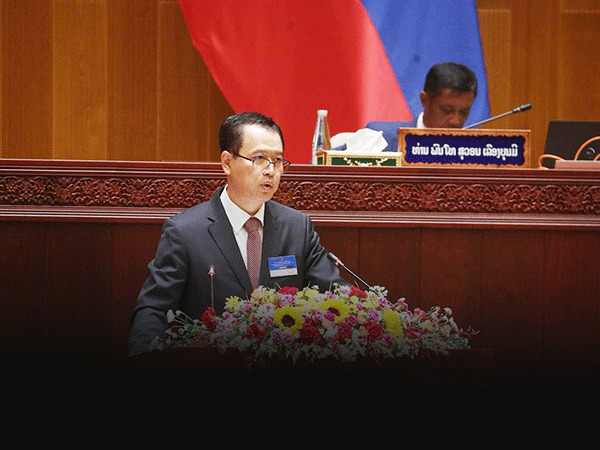 |
| Mr Malaythong Kommasith address assembly. |
Govt rolls out US$10m subsidy to ease electricity costs
The government is providing a subsidy of US$8 million to US$10 million to lower household electricity bills from September to December 2025 for consumers using up to 300 kWh a month.
The subsidy follows growing concern over high living costs and is aimed at easing pressure on low-income families grappling with rising production and energy expenses. The Ministry of Industry and Commerce said the short-term subsidy is part of broader efforts to keep electricity affordable while Laos faces heavy debt and unstable supply.
The Minister of Industry and Commerce, Mr Malaythong Kommasith, told the ongoing session of the National Assembly that the transmission fee for households will fall from 1.2 US cents to 0.5 US cents per kWh over the four-month period of the subsidy.
He said this cut will reduce the household tariff for the 0–300 kWh band to 2.4–4.9 US cents per kWh, down by 0.7 US cents from the previous range of 3.1–5.6 US cents.
Mr Malaythong said the new price is cheaper than electricity rates in neighbouring countries, and the government’s move is a direct response to proposals made by National Assembly members at the previous session.
Earlier this year, the erstwhile Ministry of Energy and Mines outlined an electricity price plan for 2025–2029 that was aimed at aligning with the business needs of Électricité du Laos, with tariffs set to rise step by step through this period.
The plan caused strong concern among the public and members of the National Assembly, who urged the government to reconsider the approach to ease the burden on families.
Mr Malaythong said Laos has expanded its energy sector from four small electricity sources in 1975 to 109 today, with an installed capacity of 12,235.84 MW. Household coverage has grown from three percent in 1975 to more than 96 percent.
But despite this expansion, the sector still faces major challenges, with electricity prices remaining high when compared to people’s incomes, rising domestic production costs, heavy accumulated debt, unstable supply in some areas, and large volumes of power exported at low prices.
“To address these issues, raising electricity prices in recent years has been an unavoidable solution,” Mr Malaythong told the National Assembly. But he said the government plans to continue gradual price adjustments to avoid any severe social impact.
According to the Minister, electricity prices between 2025 and 2029 will be separated for three sectors — agriculture, industry and households — to support production and strengthen the economy.
For agriculture, irrigation and household farming, medium-voltage 22 kV will be charged at 6.09 US cents per kWh, the lowest tariff in the non-residential category. Commercial farming businesses will pay 7.91 US cents per kWh for large-scale crop and livestock production.
Industrial users will be grouped into mineral exploration and processing, special economic zones, general processing and industrial estates. The processing industry, which forms the base of socio-economic development, will pay 7.94 US cents per kWh.
Mr Malaythong said the Ministry will work with other sectors to promote small and medium enterprises engaged in import substitution, and to encourage the use of solar rooftop systems, biomass and other alternative energy sources.
He said the Ministry will coordinate with the finance, banking and agriculture sectors, and provincial administrations to design additional support policies for farming units and targeted processing industries.
Industrial estates and special economic zones will be encouraged to produce their own energy where possible, with Électricité du Laos providing backup power when self-generation does not meet the demand.
By Phonepaseuth Volakhoun
(Latest Update November 19, 2025)
|


